The Meizu MX4 Pro Review
by Andrei Frumusanu on February 16, 2015 2:00 AM EST- Posted in
- Smartphones
- Exynos
- Mobile
- Meizu
Display Measurement
The Meizu MX4 Pro comes with a 5.46" JDI manufactured LCD. What differs from most other LCD panels that we've seen in mobile devices is that Meizu employs a much more precise backlight LED driver IC that is able to provide 2048 levels of brightness. Although this doesn't really affect everyday usage and such brightness resolution is not needed, it's the way that Meizu decides to use this in the lower brightness levels that really marks a departure from any other vendor.
Before getting into details of the low brightness performance, we'll look at the maximum luminance the display is able to achieve. As always, our display testing is done with an X-Rite i1Pro 2 as our measurement hardware, in conjunction with SpectraCal's CalMAN software suite and our own workflow to be able to get an accurate display characterization.
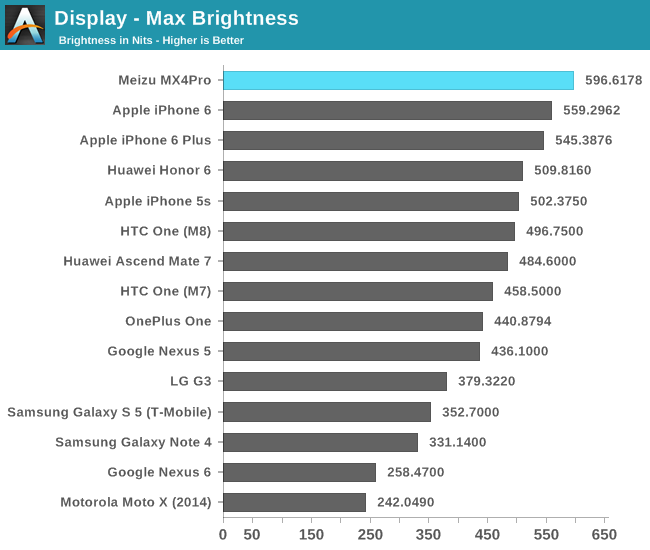
The Meizu MX4 Pro manages to dominate the brightness chart at 596 cd/m². This is easily one of the brightest devices we've tested, outperforming even Apple's iPhones. People who paid attention to Meizu's marketing materials will notice that they only proclaim a maximum brightness of 450 cd/m², and indeed my initial measurement when I received this review unit came in at a lower 484 cd/m². The increased brightness came only after I had updated the device to the 4.1l firmware, which unlocked the brightness slider to the maximum hardware brightness settings.

The black levels at maximum brightness remain quite high, providing one of the weakest performances among competing devices. Fortunately this happens only at maximum brightness as lower brightness settings such as at 200 cd/m² will achieve 0.1543 nits on black.
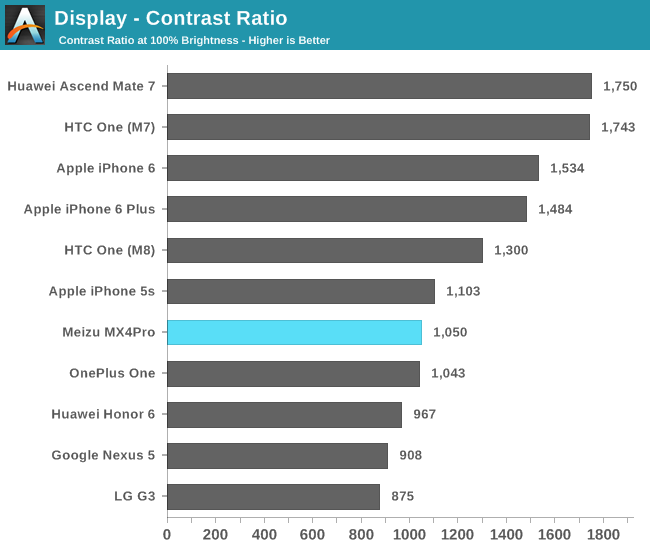
Due to the high black luminance at 100% brightness the Meizu achieves only a 1050:1 contrast ratio. Again, this only happens at maximum brightness as more normal use-cases such as our 200 nit measurement level will achieve a 1300:1 contrast ratio.
I've mentioned in the introduction that the screen is able to achieve excellent low-light brightness conditions, but nothing really prepared me for what I discovered. The MX4 Pro is able to achieve 2.7 cd/m² under the manual minimum brightness setting that is exposed via the brightness slider. This puts the Meizu at similar excellent low-light emission levels as Samsung's recent AMOLED devices such as the Galaxy S5 and the Note 4. Not only was this LCD screen able to match those the low brightness of Samsung's devices, but it managed to do it while retaining color accuracy and especially color resolution as dark grays would not suffer from the same black clipping that the recent AMOLED devices are displaying.
I specified that the 2.7 nits on the MX4 Pro was achieved with the minimum brightness slider because the actual hardware is capable of much lower settings. One might remember that Meizu markets the 2048 brightness levels of the display, however the lower 500 levels are not achievable under normal circumstances unless one goes to edit the brightness manually in the control entry of the back-light driver. Here actually setting the minimal brightness as allowed by the hardware achieves an insane 0.17 cd/m² on whites. For comparison, I took a long-exposure picture of the MX4 Pro next to the Note 4 at both their minimal allowed luminance, as seen on the left side of the picture. What really astounded me here is that the MX4 Pro remained absolutely color accurate even at this crazy low setting, as visible in the 50 second (!!) exposure of the phone on the far right.
Although going so low in brightness serves absolutely no practical use, as even in a completely dark room you will have a hard time reading content, it does prove that there is no technological barrier in LCD screens preventing manufacturers from implementing comfortable low brightness levels for reading at night. I appreciate Meizu for being one of the first manufacturers to actually allow this on LCD screens and I hope we'll be seeing wider adoption in the future.
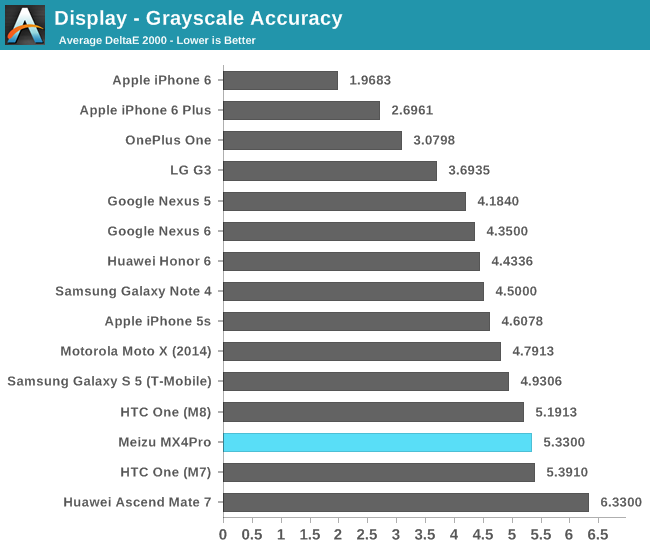
The grayscale accuracy lands at a deltaE2000 of 5.33, which represents a figure above the generally noticeable threshold of 3. The JDI screen seems to be calibrated for a cool color temperature target of 7400K, making the screen have a blueish tint on whites. There is unfortunately no setting to change the configuration of the screen.
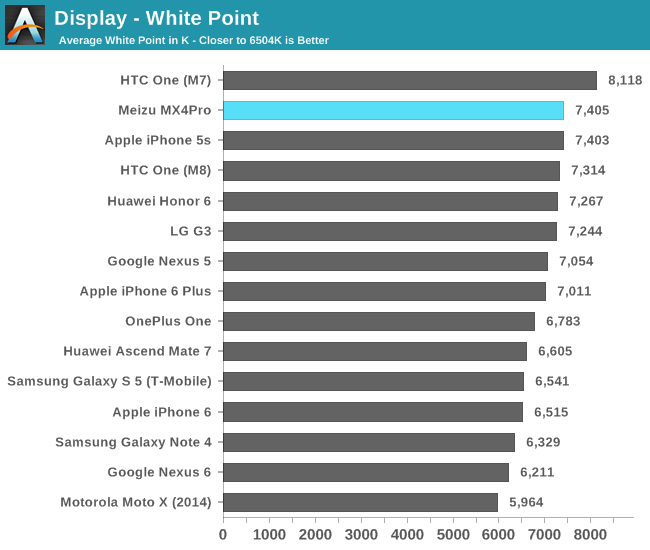

It's on the saturation accuracy where the Meizu sadly disappoints. The hue is off in the yellow and magenta spectrum, and all saturations beyond 80% suffer from significant compression. Colors are much too bright and have the radioactive look that people are familiar with on Samsung's AdobeRGB colorspace screen modes.

Due to the strong saturation compression and cold color temperature, the Gretag Macbeth color accuracy chart and deltaE2000 achieve only a disappointing figure of 4.98. This is considerably worse than other competing devices, with only the One M8 and Motorola's uncalibrated AMOLED devices performing worse.
Although the MX4 Pro impressed with its brightness, excellent sharpness, and outstanding low-light performance, it simply cannot be advised for people who appreciate color accuracy. For people who are looking for a "vibrant" and otherwise excellent display in all other aspects besides accuracy, I'm sure the Meizu MX4 Pro will more than satisfy.
Display Power
The detailed display power curve of the Note 4's AMOLED screen is something I want to translate to LCD screens too whenever I have the opportunity. The MX4 Pro's screen luminance rises exponentially to the actual brightness level of the backlight, which does have a noticeable effect on battery life tests that rely on standardized percentages rather than standard luminance.
The device power goes from from about 530mW at minimal brightness, up to 1.69W at the maximum 597 nits. Power seems to scale linearly with the luminance, meaning there should be no efficiency penalty of running the higher brightness levels. LCD screens remain the most efficient technology for high brightness mobile displays, as the break-even point for current generation AMOLEDs looks to lie at around 65% APL when displaying white content.
I couldn't measure any power difference when measuring various APL levels on the MX4 Pro, meaning that the power to drive the LCD matrix itself is negligible. It is to be mentioned that due to this being a QHD display, it suffers from the same MIPI-DSI bandwidth limitations as other 1440p smartphones, meaning the physical bandwidth of the D-PHY interface between the SoC's display controller and the display driver IC is not enough to drive the full resolution at 60fps. The Meizu MX4 Pro, much like other Exynos SoCs and the Galaxy Note 4 Exynos, is able to circumvent this limitation with help of MIC (Mobile Image Compression), enabling the phone to make due with just 4 MIPI DSI lanes and thus allowing for better power consumption in dynamic content, on top of what PSR (Panel Self Refresh) offers for static content.
With a good idea of what the screen's power and luminance characteristics are, let's continue on to the battery life tests of the MX4 Pro.


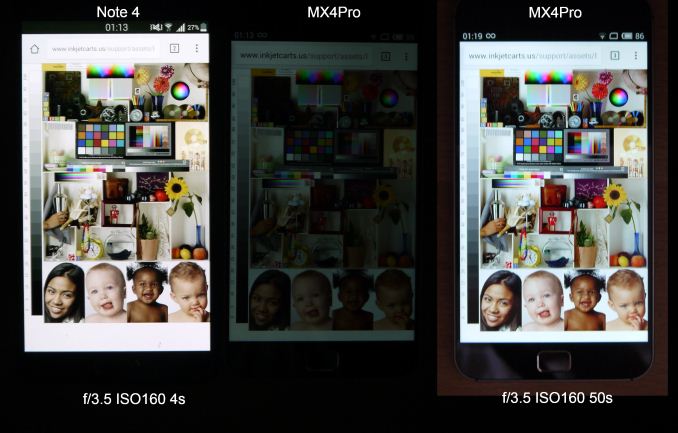
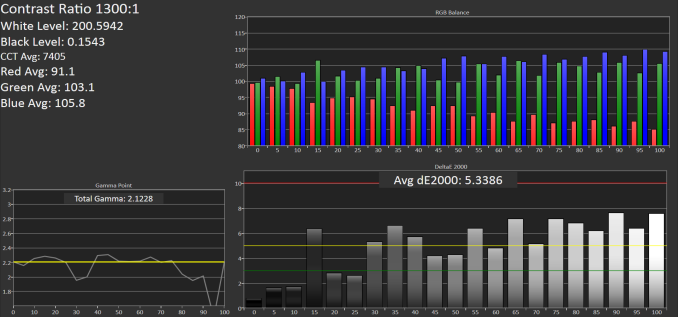
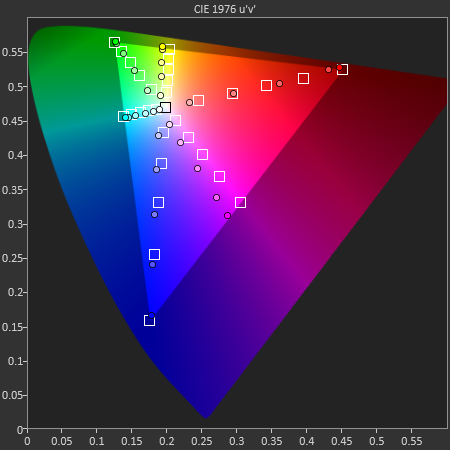

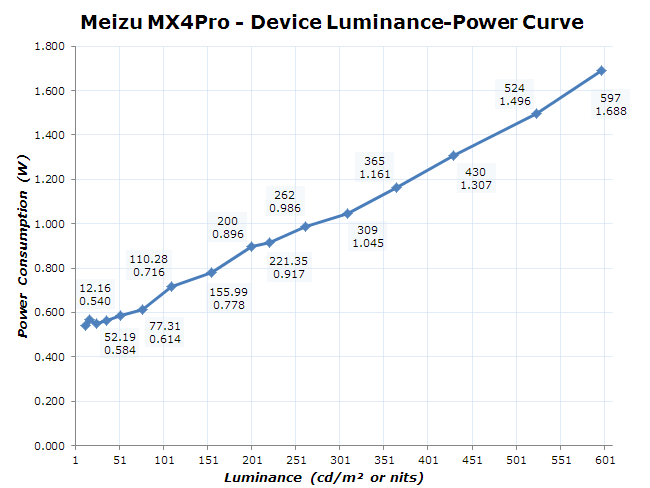








70 Comments
View All Comments
jjj - Monday, February 16, 2015 - link
I have doubts that Xiaomi still aims to make great value products and the likely Redmi Note 2 might be 720p and SSD615 but we shall see. Xiaomi or not there are a few similar devices already anyway, some even cheaper ,the only big name for matching the m1 Note now being TCL.As for A53, it is a small core , from a cost perspective it's normal to be well priced. Perf wise it is nice, for us consumers.
getbacktosrinu - Monday, February 16, 2015 - link
How come Anandtech is reviewing a Meizu, and is not reviewing phones from Sony, a much bigger brand and one of the bigger players in the international smartphone market?Why not look at the Xperia Z3 and the Z3 Compact and dig in to find out how Sony is extracting "2 - day battery life" purportedly?
jjj - Monday, February 16, 2015 - link
To be fair Sony is barely in top 10 smartphone makers - Samsung, Apple, Huawei, Lenovo, LG, Xiaomi , Coolpad , BBK (OPPO and Vivo are ahead of them and Sony fights with ZTE and TCL for the last 2 spots in top 10 - and they might sell the phone division by this time next year. Plus those devices are not exactly fresh. Meizu could be one of the next tech giants and they would likely overtake Sony in units in 2016 if not this year.At least this device is a bit different than the standard 1080p, SD80x and so on.that gets rather boring and offers little surprises.TT Masterzz - Monday, February 16, 2015 - link
Shouldn't Lenovo be the third largest after they acquired Motorola and also I believe Xiaomi is fifth and LG is sixth. Although I am not sure about thatTT Masterzz - Monday, February 16, 2015 - link
Also if we go by your logic of units shipped then I believe there should be no reason for AT to review One Plus One right ?.jjj - Monday, February 16, 2015 - link
Well you kinda overextend what i was saying but there is no logic for AT to not review devices from major phone makers that it currently ignores. OPO in the end shipped little so yeah there isn't all that much of a reason to review it. However it did ship to lots of enthusiasts and AT was about PC enthusiasts not mainstream so from that perspective it makes more sense to review the OPO than S6 or the iphone.As for phone makers rankings, i wasn't trying to list them in Q4 order or 2014 order. Lenovo has bought Moto but they had only 2 months of Moto sales in 2014 and they are not growing all that fast. Huawei shipped some 75 million units in 2014 so they were 3rd for sure and at this point the most likely to be third in 2015 as they expand the Honor line to more markets.
Anyway, in 2015 Huawei , Lenovo and Xiaomi are likely to fight for the 3rd spot with Lenovo the least likely to get it and LG could drop a few spots but that depends on their strategy .Some China guys might get in trouble this year too , HTC and Sony might have to sell so maybe we see some mergers and the rankings change a bit.
TT Masterzz - Wednesday, February 18, 2015 - link
I agree on the latter part of your comment. The Chinese market seems to be approaching saturation and inevitably this would mean the death of certain small scale Chinese manufacturers who had till now been surviving on the enormous growth rate China had. Although I beg to differ that smartphones like S6 and iPhone 6/6+ are not used by enthusiasts. Even Sony smartphones are used by enthusiasts in my opinion. Plus if AT were to only review gadgets that appeal to tech savvy users then why ignore Xiaomi products. Xiaomi's "almost" zero marketing and online flash sales pretty much guarantees that only tech enthusiasts use their smartphones. Xiaomi's volume also is much higher than One Plus. I guess the best way to put it is that AT reviews devices at their whims and fancies. Cheers :)Gemuk - Monday, February 16, 2015 - link
AT have always parroted the "we only review stuff that the manufacturer sends us" line which I just find lazy. What's so hard in actually buying the stuff, and then sell it after they're done? Heck they can even use their own forums to do so. Surely the increased revenue would be more than enough to cover the $50-100 expense?TT Masterzz - Monday, February 16, 2015 - link
They don't need to do that also. For example for the Galaxy Note 4 review the device was provided by 28mobiles.com I believe. Why can't they borrow a Sony or Xiaomi unit from 28mobiles.com and drop by a sponsored line for them. I am sure 28mobiles.com would consider providing a device if they can get a name on a website like AT.piroroadkill - Monday, February 16, 2015 - link
Yeah, it's very, very odd. Z3 Compact is STILL the best phone on the market, in my opinion.